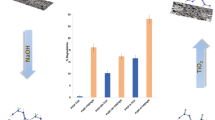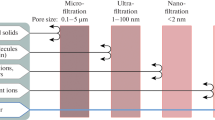Abstract
Membrane technologies are a useful solution for water treatment, especially for removing trace amounts of different pollutants. Current research is focused on improving the removal efficiency of polyvinylidene fluoride (PVDF) membranes to heavy metal ions, such as lead(II), cadmium(II), and chromium(III). The surface chemistry and morphology of PVDF membranes were varied applying the sol–gel approach for functionalization. It involved (1) diethylphosphatoethyltriethoxysilane (DPTES) or 3-mercaptopropyltrimethoxysilane (MPTMS) as functionalizing precursors, (2) different concentrations of the initial sols, and (3) NH4OH or HCl as the catalysts for the hydrolysis and co-condensation reactions. According to the SEM analysis of the surface texture, alkaline catalyst and low sol concentration result in the formation of porous membrane active layers. Membrane weight loss after water filtration under pressure indicated the dependence of layer stability on the conditions of functionalization, namely the membranes with phosphonic groups prepared in an acidic medium are more resistant to rinsing. Functionalized PVDF membranes demonstrated a significant increase in sorption efficiency along with high water flux. Overall, such membranes were sufficient for treating water with ion concentrations lower than 100 mg/L, whereas the applied functionalization technique is promising for adjusting the parameters of the final membranes.





Similar content being viewed by others
References
Abidi N, Sivade A, Bourret D et al (2006) Surface modification of mesoporous membranes by fluoro-silane coupling reagent for CO2 separation. J Membr Sci 270(1–2):101–107
Albert A, Serjeant EP (1962) Ionization constants of acids & bases. Wiley, New York
Atallah C, Tremblay AY, Mortazavi S (2017) Silane surface modified ceramic membranes for the treatment and recycling of SAGD produced water. J Petrol Sci Eng 157:349–358
Barnes GH, David MP (1960) Synthesis and hydrolytic stability of some organosilicon phosphonate esters. J Org Chem 25(7):1191–1194
Bauman M, Košak A, Lobnik A, Petrinić I, Luxbacherd T (2013) Nanofiltration membranes modified with alkoxysilanes: surface characterization using zeta-potential. Colloids Surf A Physicochem Eng Asp 422:110–117
Boroujeni AR, Karimi M, Javanbakht M (2016) Application of novel surface-modified PES membranes for removal of heavy metals from aqueous solutions. Desalin Water Treat 57(42):19794–19809
Boroujeni AR, Javanbakht M, Karimi M, Akbari-Adergani B (2017) Adsorption properties of thiol-functionalized silica nanoparticles prepared for application in poly(ether sulfone) nanocomposite membranes. J Text Polym 5(1):37–47
Chakrabarty T, Prakash S, Shah VK (2013) End group cross-linked 2-(dimethylamino) ethylmethacrylate based anion exchange membrane for electrodialysis. J Membr Sci 428:86–94
Chen JH, Zheng JZ, Liu QL et al (2013) Pervaporation dehydration of acetic acid using polyelectrolytes complex (PEC)/11-phosphotungstic acid hydrate (PW11) hybrid membrane (PEC/PW11). J Membr Sci 429:206–213
Choudhury PR, Majumdar S, Sahoo GC (2018) High pressure ultrafiltration CuO/hydroxyethyl cellulose composite ceramic membrane for separation of Cr(VI) and Pb(II) from contaminated water. Chem Eng J 336:570–578
Fang X, Li J, Li X et al (2017) Internal pore decoration with polydopamine nanoparticle on polymeric ultrafiltration membrane for enhanced heavy metal removal. Chem Eng J 314:38–49
Galve A, Sieffert D, Staudt C et al (2013) Combination of ordered mesoporous silica MCM-41 and layered titanosilicate JDF-L1 fillers for 6FDA-based copolyimide mixed matrix membranes. J Membr Sci 431:163–170
Gao A, Xie K, Song X et al (2017) Removal of the heavy metal ions from aqueous solution using modified natural biomaterial membrane based on silk fibroin. Ecol Eng 99:343–348
Graillota A, Bouyera D, Monge S et al (2013) Sorption properties of a new thermosensitive copolymeric sorbent bearing phosphonic acid moieties in multi-component solution of cationic species. J Hazard Mater 260:425–433
Gunathilake C, Kadanapitiye MS, Dudarko O et al (2015) Adsorption of lead ions from aqueous phase on mesoporous silica with P-containing pendant groups. ACS Appl Mater Interfaces 7(41):23144–23152
Han HH, Ryu SH, Nakao S, Lee YT (2013) Gas permeation properties and preparation of porous ceramic membrane by CVD method using siloxane compounds. J Membr Sci 431:72–78
Hyun SH, JoBeom SY, Kang S (1996) Surface modification of γ-alumina membranes by silane coupling for CO2 separation. J Membr Sci 120(2):197–206
Iler Ralph K (1979) The chemistry of silica: solubility, polymerization, colloid and surface properties and biochemistry of silica. Wiley, New York
Irani M, Keshtkar AR, Mousavian MA (2011) Removal of Cd(II) and Ni(II) from aqueous solution by PVA/TEOS/TMPTMS hybrid membrane. Chem Eng J 175:251–259
Košak A, Lobnik A, Bauman M (2013) Adsorption of mercury(II), lead(II), cadmium(II) and zinc(II) from aqueous solutions using mercapto-modified silica particles. Int J Appl Ceram Technol 12:461–472
Košak A, Bauman M, Padežnik-Gomilšeka J, Lobnik A (2017) Lead (II) complexation with 3-mercaptopropyl-groups in the surface layer of silica nanoparticles: sorption, kinetics and EXAFS/XANES study. J Mol Liq 229:371–379
Li X, Li J, Van der Bruggen B et al (2015) Fouling behavior of polyethersulfone ultrafiltration membranes functionalized with sol–gel formed ZnO nanoparticles. RSC Adv 5:50711–50719
Liang X, Xu Y, Sun G, Wang L, Sun Y, Qin X (2009) Preparation, characterization of thiol-functionalized silica and application for sorption of Pb2+ and Cd2+. Colloids Surf A Physicochem Eng Asp 349:61–68
Martin A, Arsuaga JM, Roldán N et al (2015) Enhanced ultrafiltration PES membranes doped with mesostructured functionalized silica particles. Desalination 357(2):16–25
Mel’nik IV, Stolyarchuk NV, Dudarko OA et al (2010) Bridged polysilsequioxane adsorption materials containing phosphonic acid residues. Prot Met Phys Chem Surf 46(2):206–214
Melnyk IV, Goncharyk VP, Kozhara LI et al (2012) Sorption properties of porous spray-dried microspheres functionalized by phosphonic acid groups. Microporous Mesoporous Mater 153:171–177
Milyutin VV, Gelis VM, Nekrasova NA et al (2014) Sorption of actinide ions onto mesoporous phosphorus-containing silicas. Radiochemistry 56(3):262–266
Oyama ST, Stagg-Williams SM (2011) Inorganic polymeric and composite membranes: structure, function and other correlations. Elsevier, New York
Qdaisa HA, Moussa H (2004) Removal of heavy metals from wastewater by membrane processes: a comparative study. Desalination 164(2):105–110
Sadeghi M, Talakesh MM, Ghalei B, Shafiei M (2013) Preparation, characterization and gas permeation properties of a polycaprolactone based polyurethane-silica nanocomposite membrane. J Membr Sci 427:21–29
Sah A, Castricum HL, Bliek A et al (2004) Hydrophobic modification of γ-alumina membranes with organochlorosilanes. J Membr Sci 243:125–132
Samiey B, Cheng C-H, Wu J (2014) Organic-inorganic hybrid polymers as adsorbents for removal of heavy metal ions from solutions. Rev Mater 7:673–726
Shi F, Ma Y, Ma J et al (2013) Preparation and characterization of PVDF/TiO2 hybrid membranes with ionic liquid modified nano-TiO2 particles. J Membr Sci 427:259–269
Singh RP, Way JD, Dec SF (2005) Silane modified inorganic membranes: effects of silane surface structure. J Membr Sci 259(1–2):34–46
Stolyarchuk NV, Kolev H, Kunachova M et al (2018) Synthesis and sorption properties of bridged polysilsesquioxane microparticles containing 3-mercaptopropyl groups in the surface layer. Colloids Surf A 538:694–702
The AWWA subcommittee on periodical publications of the membrane process committee (2008) Microfiltration and ultrafiltration membranes for drinking water. AWWA 100(12):84–97. www.jstor.org/stable/41313420
Tomina VV, Mel’nik IV, Pogorilyi RP et al (2013a) Functionalization of the surface of ceramic membranes with 3-mercaptopropyl groups using the sol–gel method. Prot Met Phys Chem Surf 49(4):386–391
Tomina VV, Melnyk IV, Zub YuL (2013b) The Impact of the nanostructure of the functional polysiloxane layer in planar ceramic membranes on their sorption properties. In: Proceedings of the international conference “nanomaterials: applications and properties”, vol 2, no 2, p 02FNC17
Tomina VV, Zub YuL, Bauman M, Kosak A, Lobnik A (2014) Mercapto-modified UF/NF membranes in heavy metals retention. In: 21st international congress of chemical and process engineering, CHISA 2014 and 17th conference on process integration, modelling and optimisation for energy saving and pollution reduction, PRES 2014
Tomina VV, Stolyarchuk NV, Melnyk IV et al (2015) Sorptive ceramic membranes functionalized with HS-groups. Microporous Mesoporous Mater 209:66–71
Tomina VV, Stolyarchuk NV, Melnyk IV et al (2016) Surface functionalization of ceramic membranes with 3-aminopropyl groups using the sol–gel method. Prot Met Phys Chem Surf 52(1):55–60
Tomina VV, Stolyarchuk NV, Melnyk IV et al (2017) Composite sorbents based on porous ceramic substrate and hybrid amino- and mercapto-silica materials for Ni(II) and Pb(II) ions removal. Sep Purif Technol 175:391–398
Wang C, Chalkova E, Lee JK et al (2011) Composite membranes with sulfonic and phosphonic functionalized inorganics for reduced relative humidity PEM fuel cells. J Electrochem Soc 158(6):B690–B697
Worthley CH, Constantopoulos KT, Ginic-Markovic M et al (2013) A study into the effect of POSS nanoparticles on cellulose acetate membranes. J Membr Sci 431:62–71
Yang H, Dong X, Wang D, Xu W (2014) Effect of silane coupling agent on physical properties of polypropylene membrane reinforced by native superfine down. Powder Polym Polym Compos 22(6):509–518
Yin N, Wang K, Wang L, Li Z (2016) Amino-functionalized MOFs combining ceramic membrane ultrafiltration for Pb(II) removal. Chem Eng J 306:619–628
Acknowledgements
This research was carried out in the framework of NATO Science for Peace Program SPS.NUKR.SFP 984398. The authors would like to express their gratitude to Tetiana Tkachenko for her help with translation into English.
Author information
Authors and Affiliations
Corresponding author
Ethics declarations
Conflict of interest
The authors declare that there is no conflict of interests.
Additional information
Publisher's Note
Springer Nature remains neutral with regard to jurisdictional claims in published maps and institutional affiliations.
Rights and permissions
About this article
Cite this article
Sliesarenko, V., Tomina, V., Dudarko, O. et al. Functionalization of polymeric membranes with phosphonic and thiol groups for water purification from heavy metal ions. Appl Nanosci 10, 337–346 (2020). https://doi.org/10.1007/s13204-019-01170-7
Received:
Accepted:
Published:
Issue Date:
DOI: https://doi.org/10.1007/s13204-019-01170-7




